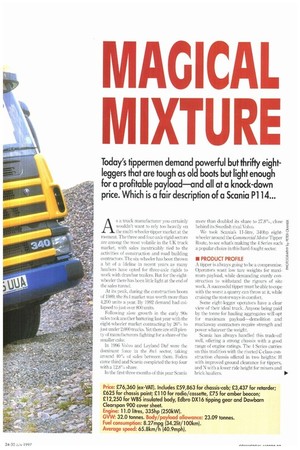MAGICAL
Page 29

If you've noticed an error in this article please click here to report it so we can fix it.
MIXTURE As a truck manufacturer you certainly wouldn't want to rely too heavily on the multi-wheeler tipper market at the moment. The three and four-axle rigid sectors are among the most volatile in the UK truck market, with sales inextricably tied to the activities of construction and road building contractors. The six-wheeler has been thrown a bit of a lifeline in recent years as many hauliers have opted for three-axle rigids to work with drawbar trailers. But for the eight. wheeler there has been little light at the end of the sales tunnel.
At its peak, during the construction boom of 1989, the 8x4 market was worth more than 4,200 units a year. By 1992 demand had collapsed to just over 800 units.
Following slow growth in the early 90s sak.s took another battering last year with the eight-wheeler market contracting by 26% to just under 2,000 trucks. Yet there are still plenty of manufacturers fighting for a share of the smaller cake.
In 1996 Volvo and Leyland Daf were the dominant force in the 8x4 sector, taking around 40% of sales between them. Foden came third and Scania completed the top four with a 12.8% share.
In the first three months of this year Scania more than doubled its share to 27.8%, close behind its Swedish rival Volvo.
We took Smnia's 11-litre, 340hp eightwheeler around the Conunercial Motor Tipper Route, to see what's making the 4 Series such a popular choice in this hard-fought sector.
A tipper is always going to be a compromise. Operators want low tare weights for maximum payload, while demanding sturdy construction to withstand the rigours of site work. A successful tipper must be able to cope with the worst a quarry can throw at it, while cruising the motorways in comfort.
Some eight-legger operators have a clear view of their ideal truck. Anyone being paid by the tonne for hauling aggregates will opt for maximum payload—demolition and muckaway contractors require strength and power whatever the weight.
Scania has always handled this trade-off well, offering a strong chassis with a good range of engine ratings. The 4 Series carries on this tradition with the riveted C-class construction chassis offered in two heights: H with improved ground clearance for tippers, and N with a lower ride height for mixers and brick hauliers.








































































































